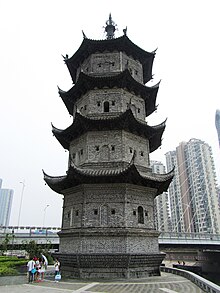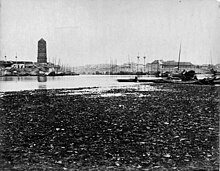 Zhongjiang Pagoda (Lighthouse) Zhongjiang Pagoda (Lighthouse) | |
| Location | Wuhu, China |
|---|---|
| Coordinates | 31°19′32″N 118°21′47″E / 31.325522°N 118.363071°E / 31.325522; 118.363071 |
| Tower | |
| Construction | concrete and wood |
| Height | 35-metre (115 ft) |
| Shape | octagonal tower with flying eaves |
| Markings | None |
Zhongjiang Pagoda (中江塔 or Jiang Tower) is a 35-metre (115 ft) five level or story Pagoda, situated between the Qingyi and Yangtze (Changjiang) Rivers in Wuhu City, Anhui Province, China.
History

The Zhongjiang Pagoda was constructed in 1618, during the Ming Dynasty, and rebuilt in 1669 during the Qing dynasty, was a navigation aid for boats and ships later known as a lighthouse, and is maintained by the Maritime Safety Administration.
The Pagoda was repaired in 1669 during the Qing Dynasty, rebuilt in 1988, and is a key preservation unit of historical and cultural relics in Wuhu. The top of the Pagoda fell off during the 2008 Sichuan earthquake.
Construction
The Zhongjiang Pagoda is octagonal in shape, constructed of concrete and wood. The second, third, and fourth floors, as well as the roof, are constructed with "flying eaves".
See also
References
- Zhongjiang Pagoda Lighthouse Archived 2016-06-04 at the Wayback Machine- Retrieved 2016-06-03
- Zhongjiang Pagoda- Retrieved 2016-06-03
- Numerical simulation of seismic damage evolution of ancient masonry pagodas in China- Seismic damage features of ancient masonry pagodas by Li Shengcai, Zhao Youjun, and Liu Yu (2014)- Retrieved 2016-06-03
- "Flying eaves"- A Jesuit Garden in Beijing and Early Modern Chinese Culture, Chapter 4 pp. 78- Purdue University Press, 2011, Author; By Hui Zou - Retrieved 2016-06-03